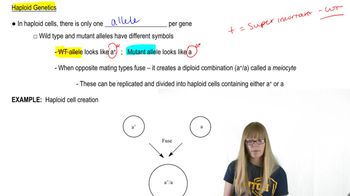Here are the essential concepts you must grasp in order to answer the question correctly.
Alu Sequences
Alu sequences are a type of short interspersed nuclear element (SINE) found in the human genome. They are approximately 300 base pairs long and are derived from the 7SL RNA gene. Alu elements are notable for their high copy number, with around 1 million copies present in a single haploid human genome, contributing to genomic diversity and evolution.
Recommended video:
Haploid Genome
A haploid genome contains a single set of chromosomes, which in humans consists of about 3 billion base pairs. This is half the number of chromosomes found in diploid cells, which contain two sets. Understanding haploidy is crucial for calculating the distribution of genetic elements, such as Alu sequences, across the genome.
Recommended video:
Base Pair Spacing
Base pair spacing refers to the average number of base pairs that separate repetitive elements like Alu sequences within the genome. To calculate this, one can divide the total number of base pairs in the haploid genome by the number of Alu copies. This metric helps in understanding the density and distribution of these genetic elements throughout the genome.
Recommended video:




